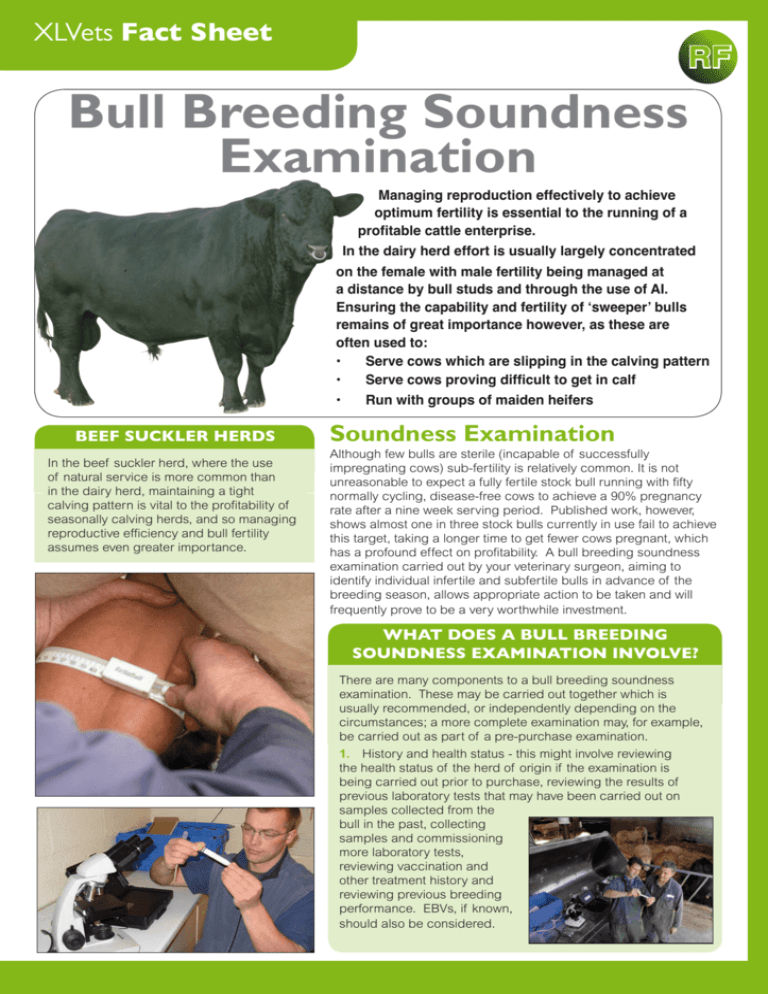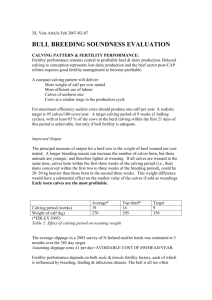Bull Breeding Soundness Examination
advertisement

XLVets Fact Sheet RF Bull Breeding Soundness Examination Managing reproduction effectively to achieve optimum fertility is essential to the running of a profitable cattle enterprise. In the dairy herd effort is usually largely concentrated on the female with male fertility being managed at a distance by bull studs and through the use of AI. Ensuring the capability and fertility of ‘sweeper’ bulls remains of great importance however, as these are often used to: • Serve cows which are slipping in the calving pattern • Serve cows proving difficult to get in calf • BEEF SUCKLER HERDS In the beef suckler herd, where the use of natural service is more common than in the dairy herd, maintaining a tight calving pattern is vital to the profitability of seasonally calving herds, and so managing reproductive efficiency and bull fertility assumes even greater importance. Run with groups of maiden heifers Soundness Examination Although few bulls are sterile (incapable of successfully impregnating cows) sub-fertility is relatively common. It is not unreasonable to expect a fully fertile stock bull running with fifty normally cycling, disease-free cows to achieve a 90% pregnancy rate after a nine week serving period. Published work, however, shows almost one in three stock bulls currently in use fail to achieve this target, taking a longer time to get fewer cows pregnant, which has a profound effect on profitability. A bull breeding soundness examination carried out by your veterinary surgeon, aiming to identify individual infertile and subfertile bulls in advance of the breeding season, allows appropriate action to be taken and will frequently prove to be a very worthwhile investment. WHAT DOES A BULL BREEDING SOUNDNESS EXAMINATION INVOLVE? There are many components to a bull breeding soundness examination. These may be carried out together which is usually recommended, or independently depending on the circumstances; a more complete examination may, for example, be carried out as part of a pre-purchase examination. 1. History and health status - this might involve reviewing the health status of the herd of origin if the examination is being carried out prior to purchase, reviewing the results of previous laboratory tests that may have been carried out on samples collected from the bull in the past, collecting samples and commissioning more laboratory tests, reviewing vaccination and other treatment history and reviewing previous breeding performance. EBVs, if known, should also be considered. XLVets Bull Breeding Soundness Examination 2. Physical examination - this begins at a distance assessing size relative to age, body condition, conformation, locomotion and noting signs that might be consistent with the presence of any infectious or contagious disease. A more detailed examination may then be required particularly to assess the eyes, the teeth, the legs and feet and, of course, the reproductive apparatus. The prepuce will be examined for any evidence of constriction or discharge. The penis will be palpated to ensure that it is freely moveable within the prepuce and that there is no evidence of any abnormal swellings or growths. The testes will be measured (size correlates with sperm production and offspring fertility) and palpated to ensure uniform size and consistency and that they are freely moveable within the scrotum. An internal examination will also usually be carried out to palpate the accessory reproductive apparatus and ensure normality. Reproduction / Fertility RF 3. Semen collection and examination - the best quality samples can be obtained by teasing the bull with a cow that is in oestrus and then using an artificial vagina but the use of electro-ejaculation will usually result in an acceptable quality sample being obtained more quickly and safely. (A few bulls will fail to respond satisfactorily to electro-ejaculation and no sample will be obtained.) An assessment will be made of ejaculate volume and density before the sample is viewed using a microscope to assess sperm motility and the number of abnormal or damaged sperm. 4. Libido and serving assessment - watching the bull’s behaviour whilst working allows an assessment to be made of his libido (how keen he is to serve cows) and of his ability to serve. It is particularly important during this part of the examination to watch carefully for any penile deviations which may prevent intromission (the penis entering the vagina) and for evidence of an ejaculatory thrust. Why do bulls fail breeding soundness examinations? The reasons, of course, are many and varied. Immaturity, poor body condition or lameness might be able to be addressed, resulting in a useful breeding animal in the future. Other conditions, including health status (persistent infection with BVD, for example), penile damage or deviation and inadequate testicular size will provide grounds for immediate rejection of the bull as a breeding animal. Acknowledgements We would like to thank the following people for their involvement in the production of this factsheet and the accompanying workbook. Editorial and images: Keith Cutler, Endell Veterinary Group, Phil Alcock and Jonathan Statham, Bishopton Veterinary Group. Notice & Disclaimer: The contents of this factsheet are not intended to be a substitute for appropriate direct advice from a veterinary surgeon. XLVets and/or its member practices give no guarantee that the contents of this factsheet are comprehensive, wholly accurate or relevant to all situations. FarmSkills Mill Farm, Studley Road, Ripon, Yorkshire HG4 2QR T: (01765) 608489 E: farmskills@xlvets.co.uk www.farmskills.co.uk XLVets Committed to UK farming. Go to www.xlvets.co.uk
